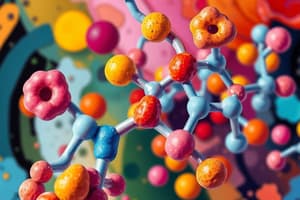Podcast
Questions and Answers
Which of the following is NOT a characteristic of lipids?
Which of the following is NOT a characteristic of lipids?
- They can be used as a source of energy.
- They include fats, oils, waxes, and steroids.
- They are water-soluble. (correct)
- They are primarily composed of carbon, hydrogen, and oxygen in a 2:1 ratio.
What is the primary difference between saturated and unsaturated fats?
What is the primary difference between saturated and unsaturated fats?
- Saturated fats have the maximum number of hydrogen atoms bonded to their carbon chains, while unsaturated fats do not. (correct)
- Saturated fats have at least one double bond in their fatty acid chains, while unsaturated fats do not.
- Saturated fats are liquid at room temperature, while unsaturated fats are solid.
- Saturated fats are typically found in plant sources, while unsaturated fats are found in animal sources.
Which of the following is NOT a function of proteins?
Which of the following is NOT a function of proteins?
- Defense against pathogens
- Storage of genetic information (correct)
- Structural support
- Transport of molecules
What type of bond connects amino acids together to form a polypeptide chain?
What type of bond connects amino acids together to form a polypeptide chain?
Which level of protein structure describes the overall three-dimensional shape of a single polypeptide chain?
Which level of protein structure describes the overall three-dimensional shape of a single polypeptide chain?
What happens to a protein when it is denatured?
What happens to a protein when it is denatured?
What is the role of an enzyme in a chemical reaction?
What is the role of an enzyme in a chemical reaction?
How do competitive inhibitors affect enzyme activity?
How do competitive inhibitors affect enzyme activity?
Flashcards
Macromolecules
Macromolecules
Large molecules essential for life, including carbohydrates, lipids, proteins, and nucleic acids.
Monosaccharide
Monosaccharide
The simplest form of carbohydrates, consisting of one sugar unit.
Polysaccharides
Polysaccharides
Carbohydrates made up of many monosaccharides linked together, serving storage or structural roles.
Triglyceride
Triglyceride
Signup and view all the flashcards
Saturated Fats
Saturated Fats
Signup and view all the flashcards
Amino Acids
Amino Acids
Signup and view all the flashcards
Denaturation
Denaturation
Signup and view all the flashcards
Enzymes
Enzymes
Signup and view all the flashcards
Study Notes
Macromolecules
- Carbohydrates (Sugars):
- Monomers are monosaccharides (e.g., glucose)
- Ratio of monosaccharides is CH₂O
- Glycosidic linkages join monosaccharides
- Polysaccharides are polymers of sugars
- Storage (starch, glycogen) or structural (cellulose) roles
- Starch and glycogen are energy storage for plants and animals respectively.
- Cellulose forms plant cell walls.
- Chitin is in exoskeletons and fungal cell walls.
Lipids
- Fats, oils, and waxes
- Not polymers
- Made of glycerol and fatty acids
- Energy storage
- Provide insulation and cushioning
- Saturated fats are solid at room temp (e.g.,animal fats) while unsaturated fats are liquid (e.g., vegetable oils)
- Phospholipids have both polar and nonpolar parts, critical component of cell membranes.
- Steroids have a 4-fused ring structure (e.g., cholesterol)
Proteins
- Monomers are amino acids
- Polymers are polypeptides
- Many functions (structural support, transport, defense, enzymes)
- Amino acids linked via peptide bonds
- 4 levels of protein structure (primary, secondary, tertiary, quaternary)
- Denaturation is the loss of protein structure due to changes in pH or temperature.
Nucleic Acids
- Monomers are nucleotides
- Polymers are DNA and RNA
- Carry genetic information
- Nucleotides consist of a sugar, a phosphate, and a nitrogenous base.
- DNA and RNA have different functions and structures, DNA is a double helix and RNA is usually single-stranded.
Carbohydrate Tests
- Benedict's Test: Detects reducing sugars. A positive result shows color change (e.g., from blue to orange/red).
- Iodine Test: Detects polysaccharides. A positive result shows a color change (e.g. from amber to dark purple/blue-black).
Lipid Tests
- Lipid tests involve observing whether a solution forms a separate layer upon mixing.
Protein Tests
- Biuret Test: Detects proteins. A positive result produces a purple color change.
Studying That Suits You
Use AI to generate personalized quizzes and flashcards to suit your learning preferences.
Related Documents
Description
Explore the fascinating world of macromolecules including carbohydrates, lipids, and proteins. This quiz covers the structure, function, and significance of these essential biological molecules. Test your understanding of monomers, polymers, and their roles in living organisms.




